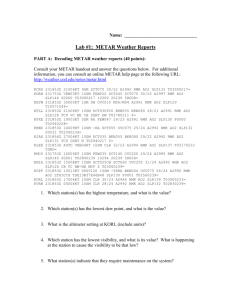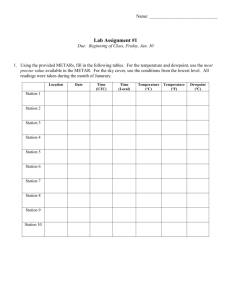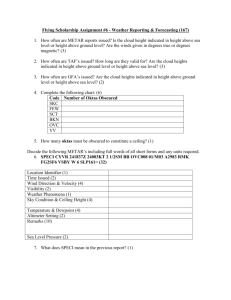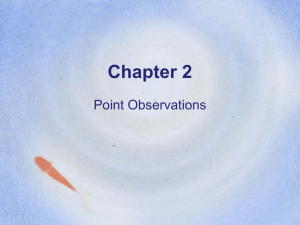Students will decode a METAR report and convert the decoded... plot. abilities necessary to do scientific inquiry, properties and changes of...
advertisement
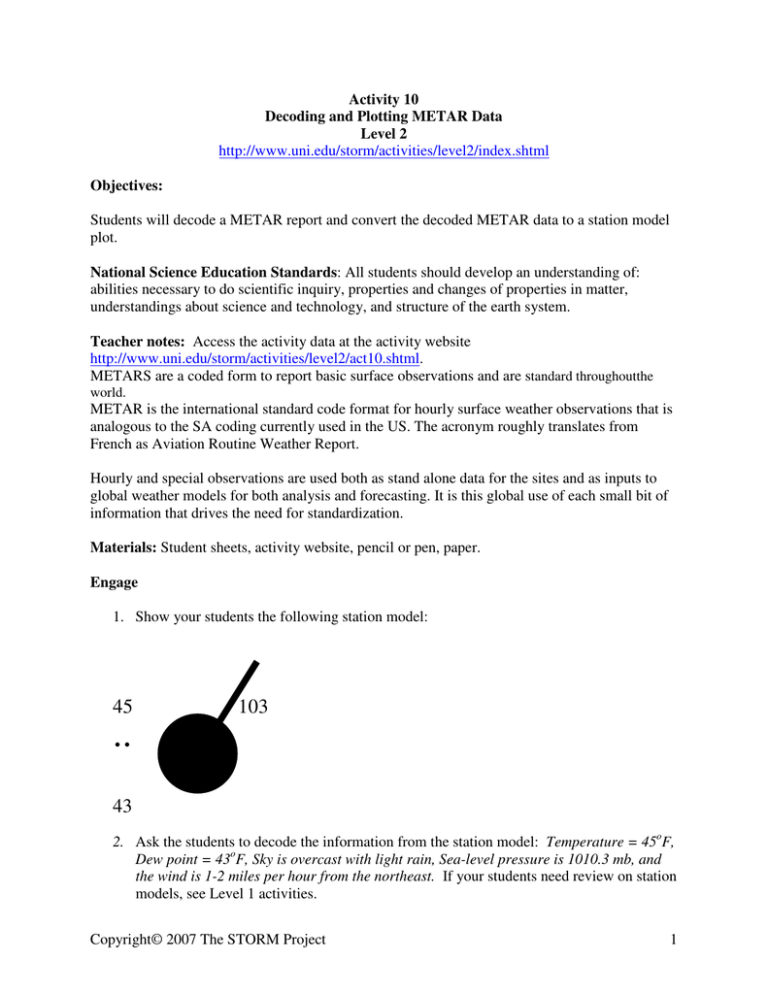
Activity 10 Decoding and Plotting METAR Data Level 2 http://www.uni.edu/storm/activities/level2/index.shtml Objectives: Students will decode a METAR report and convert the decoded METAR data to a station model plot. National Science Education Standards: All students should develop an understanding of: abilities necessary to do scientific inquiry, properties and changes of properties in matter, understandings about science and technology, and structure of the earth system. Teacher notes: Access the activity data at the activity website http://www.uni.edu/storm/activities/level2/act10.shtml. METARS are a coded form to report basic surface observations and are standard throughoutthe world. METAR is the international standard code format for hourly surface weather observations that is analogous to the SA coding currently used in the US. The acronym roughly translates from French as Aviation Routine Weather Report. Hourly and special observations are used both as stand alone data for the sites and as inputs to global weather models for both analysis and forecasting. It is this global use of each small bit of information that drives the need for standardization. Materials: Student sheets, activity website, pencil or pen, paper. Engage 1. Show your students the following station model: 45 103 ·· 43 2. Ask the students to decode the information from the station model: Temperature = 45oF, Dew point = 43oF, Sky is overcast with light rain, Sea-level pressure is 1010.3 mb, and the wind is 1-2 miles per hour from the northeast. If your students need review on station models, see Level 1 activities. Copyright© 2007 The STORM Project 1 Explore: 1. Show your students the following coded METAR data example: KMSP 241153Z VRB03KT 10SM FEW150 SCT200 BKN250 19/12 A3008 RMK AO2 SLP183 P0013 60170 T01890117 (Note: you can access METAR data at the activity website if you choose to use current reports) 2. Have your students study the METAR report and brainstorm about what the data means. Some might recognize the station name, date and time. Other’s might realize the wind is variable, etc. Explain: Talk students through decoding the report: KMSP 241153Z VRB03KT 10SM 1 2 3 4 1= Station Identifier All stations in the US start with the letter K. What are some examples of stations that start with the letter K? KMSP 241153Z VRB03KT 10SM 1 2 3 4 2 = Circle the first 2 numbers, which are the date and underline the last 4, which are the time in UTC or Z time or issuance of the report. KMSP 241153Z VRB03KT 10SM 1 2 3 4 3=Wind direction and speed • VRB means variable, most times it will start with a number. The first two digits (with a zero added to the end) are the direction. 03KT refers to the wind speed in knots. If the wind had been from a specific direction, say nearly southwest at 220 degrees, and 15 knots with gusts to 25, then this section would have looked as follows: 22015G25KT KMSP 241153Z VRB03KT 10SM 1 2 3 4 4-Visibility in statute miles = 10 SM The rest of the METAR report can be interpreted as: FEW150 SCT200 BKN250 19/12 A3008 RMK AO2 SLP183 P0013 60170 T01890117 Few clouds at 15000 feet, scattered clouds at 20,000 feet, broken clouds at 25000 feet. Temperature = 19oC/Dew point = 12oC. A 3008 is an altimeter reading of 30.08 inches. RMK A 02 means Remark A 02 which indicates an automated surface station with a precipitation discriminator. Copyright© 2007 The STORM Project 2 SLP183 is a sea level pressure of 1018.3 mb. POO13 indicates 13/100 inches of precipitation fell in the past one hour. 60170 indicates 170/100 inches, or 1.70 inches of precipitation fell in the past six hours. T01890117 indicates the station, in the past hour reported a temperature, to the nearest tenth of a degree Celsius, of +18.9o and dew point, to the nearest tenth of a degree Celsius, of +11.7o . (A complete guide to decoding METARS appears on the activity website. Now display the activity website and show students how to pick states and stations to obtain updated METAR reports. Walk them through one more explanation of the coded data. Extend: 1. At the activity website, http://www.uni.edu/storm/activities/level2/act10.shtml , obtain a coded METAR report from two stations in a state of your choice. 2. Write down the report and then decode the report. 3. Make a station model for each station. Evaluate: 1. Collect and evaluate student sheets and station models. 2. Have students write a report with data analysis and conclusions. For Further Inquiry: Have your students do one month of collecting temperature and precipitation data from METAR reports. At the end of the time frame have the students place the data in graph form. Analyze the graphs looking for seasonal patterns and trends. Or have your students design an investigation to answer any questions they might have about decoding METAR data. Copyright© 2007 The STORM Project 3 Activity 10 Decoding and Plotting METAR Data Student Sheets Engage: Decode the following station model, listing the weather conditions. 45 103 ·· 43 Temperature __________ Dew point __________ Sky cover __________ Wind direction __________ Precipitation __________ Wind speed __________ Air Pressure __________ Explore: Study the following weather data. Follow your teacher’s instructions and try to interpret the meaning of the data. KMSP 241153Z VRB03KT 10SM FEW150 SCT200 BKN250 19/12 A3008 RMK AO2 SLP183 P0013 60170 T01890117 Explain: Your teacher will explain how to decode the data, which are called coded METAR reports. You will also learn the meaning of the acronym METAR. Extend: 1. At the activity website, http://www.uni.edu/storm/activities/level2/act10.shtml, obtain a coded METAR report from two stations in a state of your choice, or use the data shown after number 3 below. 2. Write down the report and then decode the report. 3. Make a station model for each station. Copyright© 2007 The STORM Project 4 KLAX 021850Z 22006KT 10SM FEW220 BKN250 17/05 A3014 RMK AO2 SLP207 T01720050 KOAK 021853Z 15012KT 10SM -RA FEW015 SCT060 OVC095 13/06 A3010 RMK AO2 RAB43 SLP192 P0000 T01330061 KSNA 021853Z VRB03KT 10SM BKN250 18/02 A3014 RMK AO2 SLP206 T01780022 KSFO 021856Z 11009KT 10SM -RA FEW050 BKN070 OVC100 12/06 A3008 RMK AO2 RAB48 SLP186 P0000 T01220061 KSAC 021853Z 12005KT 10SM CLR 13/06 A3011 RMK AO2 SLP195 T01330061 KAPC 021854Z COR 09011KT 10SM FEW020 BKN090 OVC150 12/07 A3009 RMK AO2 SLP179 T01220072 KMOD 021853Z 13008KT 10SM FEW100 16/08 A3009 RMK AO2 SLP191 T01560078 KRDD 021853Z 14006KT 10SM -RA FEW026 OVC034 10/06 A3012 RMK AO2 SLP200 P0001 T01000056 Copyright© 2007 The STORM Project 5
